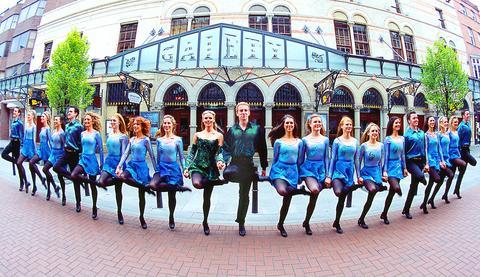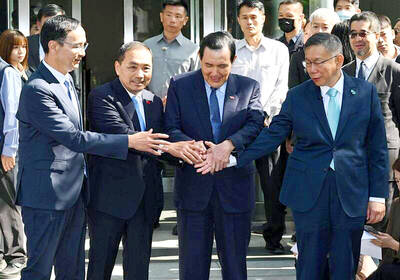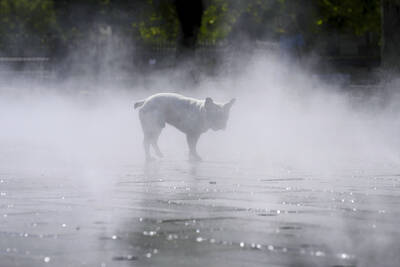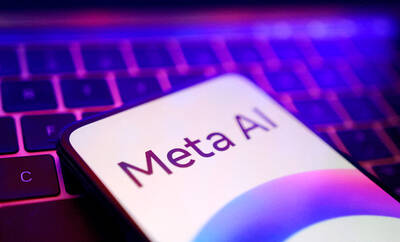It was supposed to be a sideshow, a six-minute slice of traditional Irish culture given a glitzy makeover and squeezed into an interval during the 1994 Eurovision Song Contest.
But Riverdance stole the show on that spring night in Dublin and has since gone on to become one of the biggest showbusiness phenomena the world has ever seen.
Since the troupe first pranced across the Eurovision stage, clicking their heels and high-kicking to the sound of Irish fiddles and flutes, Riverdance has played over 6,000 times in more than 220 venues.

PHOTO: REUTERS
It has visited 27 countries from Mexico to Malaysia, played before more than 16 million people and been seen on television by 1.5 billion viewers -- 300 times the population of Ireland.
Sales of Riverdance merchandizing have netted more than US$35 million worldwide. There are more than 6 million Riverdance videos spread across the globe and 2 million CDs.
Next month, the river flows home to Dublin for a special 10th anniversary show in the intimate and ornate surroundings of the 19th century Gaiety Theatre.
It will be produced by Julian Erskine, who has worked with Riverdance almost since its conception and who still recalls the moment in 1994 when Irish dancing suddenly became sexy.
Star quality
Erskine was at the Gaiety on the night of the Eurovision Song Contest, working on a production of Sean O'Casey's classic Irish drama The Plough and the Stars. Eurovision was taking place at The Point, on the other side of the city.
"We were backstage, with half an eye on the television, when Riverdance came on," he said. "The room went quiet and everyone just stood and stared in amazement at what was happening on the screen.
"By the end of the performance, I was one of those wide-eyed innocents jumping up and down, shouting how wonderful it was."
Before the year was out, a Riverdance single had shot straight to number one in the Irish charts where it remained for 18 consecutive weeks -- a record which still stands.
In 1995 it crossed the Irish Sea to set a box office record of 151 sell-out shows at London's Hammersmith Apollo and the following year it conquered America, opening at New York's Radio City Music Hall in St Patrick's Week.
The rest of the world soon surrendered. Not even a fire at a venue in Madrid in 2001 could stem the tide -- although it did destroy much of the troupe's equipment.
But what is Riverdance all about, and why has it been so successful?
According to its promoters, it is about more than dancing: it is about the life of a river, and how rain falls from the sky, seeps into streams, flows into the sea and then evaporates into the clouds only to fall as rain again.
"The river ... symbolizes the life cycle, and echoes the Irish experience of emigration and renewal," the show's promoters say. It is about "people who had left their homeland and traveled across the sea".
`Blown away'
Whether you buy into that or dismiss it as half-baked Celtic mysticism, there is no doubt Riverdance has struck a chord with the Irish diaspora across the world.
Sinead McCafferty, lead female dancer in next month's show, was brought up in Canada while her male dance partner Conor Hayes was raised in Australia. Both were born in Ireland but emigrated with their parents as infants.
"Our whole world in Toronto was Irish," recalls McCafferty, who learned Irish dancing as a child but abandoned it to take up modeling. "We were the only ones in our family who left Belfast and our life in Canada revolved around Irish music and culture.
"When I saw Riverdance I was blown away by it. It inspired me to start dancing again."
Riverdance was perhaps the most extravagant expression of a new-found confidence which swept Ireland in the 1990s.
After decades of economic hardship and sectarian violence in Northern Ireland, it once again felt good to be Irish and to celebrate Irish culture.
Ten years on, and despite being dismissed by some critics as over-hyped Irish kitsch, the river shows no sign of drying up.
The song that won that 1994 Eurovision Song Contest -- Rock 'n' Roll Kids -- is long since forgotten.
So, when Eurovision is staged in Turkey this weekend, keep an eye out for the interval act.
It might just steal the show.

Has the Taiwan People’s Party (TPP) changed under the leadership of Huang Kuo-chang (黃國昌)? In tone and messaging, it obviously has, but this is largely driven by events over the past year. How much is surface noise, and how much is substance? How differently party founder Ko Wen-je (柯文哲) would have handled these events is impossible to determine because the biggest event was Ko’s own arrest on multiple corruption charges and being jailed incommunicado. To understand the similarities and differences that may be evolving in the Huang era, we must first understand Ko’s TPP. ELECTORAL STRATEGY The party’s strategy under Ko was

It’s Aug. 8, Father’s Day in Taiwan. I asked a Chinese chatbot a simple question: “How is Father’s Day celebrated in Taiwan and China?” The answer was as ideological as it was unexpected. The AI said Taiwan is “a region” (地區) and “a province of China” (中國的省份). It then adopted the collective pronoun “we” to praise the holiday in the voice of the “Chinese government,” saying Father’s Day aligns with “core socialist values” of the “Chinese nation.” The chatbot was DeepSeek, the fastest growing app ever to reach 100 million users (in seven days!) and one of the world’s most advanced and

It turns out many Americans aren’t great at identifying which personal decisions contribute most to climate change. A study recently published by the National Academy of Sciences found that when asked to rank actions, such as swapping a car that uses gasoline for an electric one, carpooling or reducing food waste, participants weren’t very accurate when assessing how much those actions contributed to climate change, which is caused mostly by the release of greenhouse gases that happen when fuels like gasoline, oil and coal are burned. “People over-assign impact to actually pretty low-impact actions such as recycling, and underestimate the actual carbon

An internal Meta Platforms document detailing policies on chatbot behavior has permitted the company’s artificial intelligence creations to “engage a child in conversations that are romantic or sensual,” generate false medical information and help users argue that Black people are “dumber than white people.” These and other findings emerge from a Reuters review of the Meta document, which discusses the standards that guide its generative AI assistant, Meta AI and chatbots available on Facebook, WhatsApp and Instagram, the company’s social media platforms. Meta confirmed the document’s authenticity, but said that after receiving questions earlier this month, the company removed portions which stated